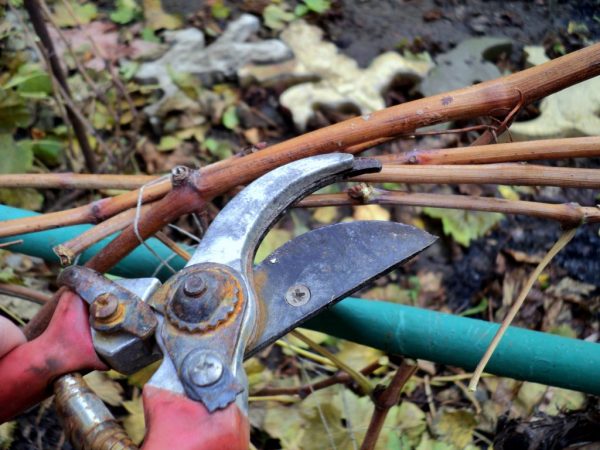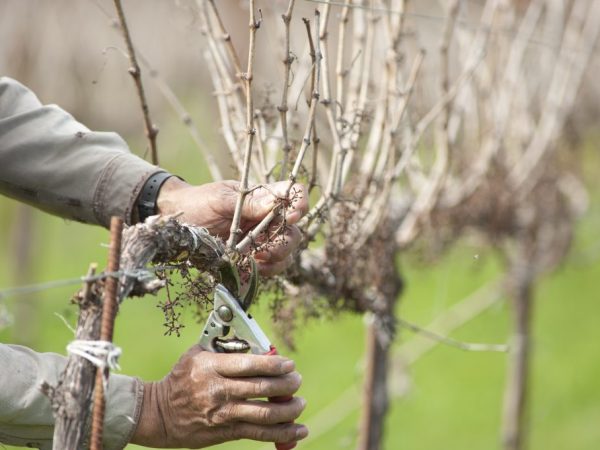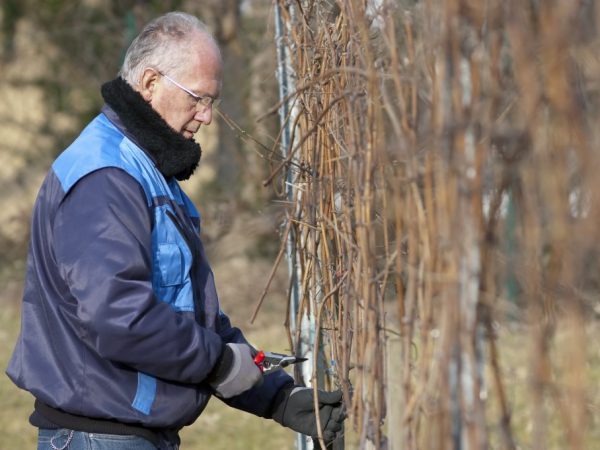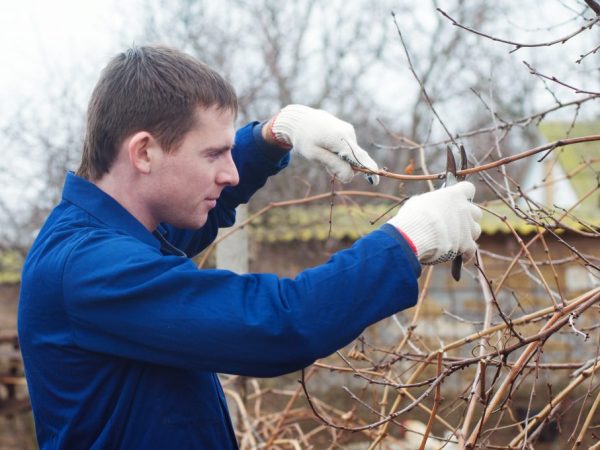Methods for shaping grape bushes
One of the most important manipulations in the cultivation process is the shaping of the grapes. The main task of this procedure is considered to be the creation of a compact crown with rational use of the land plot and obtaining a good harvest. The formation of grapes is carried out in several ways.

Methods for shaping grape bushes
The principles of forming bushes
To get beautiful, strong and productive bushes, several important nuances are taken into account:
- In Siberia and in the Urals, the culture needs shelter, so it is worth using the stampless formation of bushes. With this method, it will turn out to form short or long sleeves with the ability to tilt to the ground. This Moser procedure helps to protect the vines from freezing.
- In the Moscow region and regions of the middle lane, non-covering varieties can be formed on boles of different heights.
- In areas with a warm climate, where the soil warms up quickly, a high-standard formation of a grape bush is used.
- Multi-arm formation of a grape bush (a two-arm or three-arm culture is obtained) is used on large areas. Small bushes form on barren and poorly moistened soil.
- For vigorous varieties in the eastern regions and the Black Sea region, multi-arm grapes with long sleeves are made.
- Western European varieties are characterized by an average vigor of growth, therefore, a procedure of medium and small size is used for them.
The importance of proper shaping
Correct and timely formation of grape bushes is the key to their longevity and fertility. Carrying out such a manipulation, it is important to take into account not only the region of cultivation, but also the cultivar, the agricultural technique of its growth and development.
A competent scheme for pruning the vine contributes to:
- increasing productivity indicators;
- improves the taste and marketability of fruits;
- facilitates vineyard care;
- prevents the appearance of pathogenic flora;
- makes the crown shape compact and decorative.
Views
Winegrowers use different forms of the grape bush: bole, fan, standard, small fan, capitate and arbor formation.
The correct formation of a grape bush in the first year after planting a seedling or cuttings is carried out as follows: strong vines (1-3 pcs.) Develop from one or two pairs of buds. Over the summer, the shoots reach 1-1.5 m in height. The next year, in early spring, the vines freed from shelter are pruned according to one of the existing schemes.
The procedure is carried out annually for 3-6 years, depending on the chosen pruning method. It is finished after the fruitful shoots are formed on the bush and it starts to consistently give good yields.
Bsstambovy method

Forming bushes is not difficult
The standard pattern of Guyot formation is the most suitable for the hiding viticulture regions.
This is the easiest and most affordable even for novice gardeners to prune a vine on young grapes.
Stages of the
Young bushes are pruned in several stages:
- Formation of grapes in the first year is not carried out. After planting, the main goal is to grow a strong bush. In the fall, it is pruned, leaving only 1 pair of buds above ground level or above the grafted area. Some are insured and leave not 2, but 3 kidneys.
- The next year, 2 large shoots grow from the remaining buds. In autumn, before the onset of the first frost, they are trimmed: the first branch - on a twig. The result is a scion with 2 or 3 buds. At the second, only the top is cut, since it will bear fruit in the future.
- In the third year, another twig and a fruiting shoot will grow from a two-year-old knot.
- In the process of forming a grape bush, which has already begun to bear fruit, at least 2 pairs of buds are left (ideally, there should be at least 3 and no more than 6 pairs). Also, from the moment of fruiting, the coordination of the load of the bush is carried out.
- With vertical growth, fertile vines are fixed horizontally at an arch or on a trellis structure.
- In the third year, annual fruiting shoots are formed from the fruiting vines. In order for the young branches to develop well, they are installed vertically and fixed on the arch along with the knots.
- With the onset of autumn, pruning of old fruitful and one-year-old fruit shoots is performed. The shoots are trimmed to a knot. As a result of this type of formation of the grape bush, a twig and 2 growing arrows remain. Next year, new twigs and young shoots will form from them.
This pruning of grapes and the formation of shrubs is carried out in all subsequent years.
For vigorous and technical varieties with a high load, the fruit link is strengthened according to the Guyot scheme. A replacement knot with 3 eyes is left, and the fruiting branch is fixed horizontally or vertically. As a result, 3 branches are formed from such replacement knots. One will go to the formation of a knot, the other two - for further fruiting.
Fan-like shaping
Formation of grapes in a fan was developed by Sergey Sidoryaka. The essence of this method is to place fruit branches on any support in a fanned position. With this method, from 3 to 5 fruit arrows are formed.
The method of fanning grapes has several advantages:
- facilitates vineyard care;
- convenient for hiding bushes;
- makes it possible to coordinate the number of main branches and fruitful shoots;
- facilitates the procedure for rejuvenating bushes;
- as a result, the vineyard produces good and tasty yields.
In this way, it is possible to form:
- undersized and vigorous bushes;
- with a stem and without a stem;
- with long and short arrows;
- one-sided or two-sided shrub;
- with the placement of fruit branches in several tiers.
Step by step diagram

Pruning must be done correctly
For the standard formation of grapes, non-covering varieties are used, grown in the southern zone.
In a harsh climate, a stampless (half-fan) formation is more often used:
- In the first 2 years of life, seedlings are formed according to the same scheme as in the previous case. In the third year, more attention is paid to the sleeves. The main task is to form 2 branches on each of them.
- At the 3rd year of life, such a plant begins to form the first clusters with fruit ovaries. On it, 2 pairs of fruit branches about 1 m long are formed.In the fall, they are cut to the length of the sleeves - up to 50 cm.
- With the arrival of spring, annual shoots are pruned. Only 2-3 of the strongest are left for the formation of new fruit vines and lengthening of the sleeves. In the south, before the onset of autumn frosts, tendrils and all green shoots that did not have time to woody are cut off. In well-ripened vines, the upper shoot is cut to increase and improve yields.
- At the 4th and 5th year of life, fruit branches are re-formed on the matured arms. For the arrow, on which the berries will form, cut the upper vine by 5-6 buds. The lower branch is cut into 2-3 buds in the same way as the replacement knot.
By mature age, 6 to 8 sleeves are formed on the bush. This method ensures uninterrupted growth and development of the sleeves in length.
For long-term fruiting, the bushes are covered with any material that allows air to pass through. Shoots are used to replace old sleeves and are used to rejuvenate old bushes.
Cordon formation
This method, developed by GV Belikova, involves the cultivation of bushes on a vertical trellis. It is well suited for regions where non-covering varieties are grown.
Benefits
Forming a cordon has several advantages:
- improved accessibility during care;
- good breathability and illumination of the vineyard;
- increased productivity.
The main drawback is that the grapes, formed according to the cordon type, are less adapted to the continental climate than the fan-shaped forms of the grape bush.
There are different types of cordons:
- horizontal inclined type (one or two-tiered);
- vertical type.
Option 1
This method from Natalia Puzenko improves the quality and quantity of grape bushes. After such pruning, the formation of a grape bush is carried out as follows:
- the sleeves are fixed horizontally on the lower rows of the trellis;
- the upper part of the sleeves is left untouched: new fruitful branches will form on it;
- all the lower kidneys must be removed, so the lower part of the sleeve gradually dies off.
Option 2

The method is used for non-covering varieties
In the first year, the formation of a grape bush by this method is carried out according to the following principle:
- the formed main branches are attached to the trellis vertically;
- all the buds formed below the lowermost wire blind, leaving only one, the uppermost one, under the wire;
- in subsequent years, at a distance of 30-40 cm, 1-2 buds are left, located in different directions; from these buds cordon shoulders will develop in the future.
This manipulation is done on all tiers. If necessary, lengthening the sleeves leave one upper eyelet.
To speed up the process of acquiring plants with young growth, internodes and reduce the growth of stepchildren, it is necessary to apply a vertical scheme.
With horizontal formation, stepchildren do not develop so actively, internodes are formed short, the growth of young branches decreases.
Moscow standard small fan
This formation of grapes in the very first year is suitable for a small home vineyard.
This shaping allows you to make the bushes of a compact shape and thereby save space on the site.
Growing grapes in the open field according to this system allows you to place the bushes at a distance of 50-60 cm from each other, the row spacing is about 1.5-2 m.
If every autumn such bushes are provided with a good shelter from dry breathable material, they will live about 10 years, will bear fruit stably and quickly recover. In the regions of the middle and northern strip, a half-fan formation or a one-sided fan is used.
Capitate
This is an accelerated summer formation of a young bush, which implies compliance with all agrotechnical measures for growing crops: autumn or spring planting of seedlings in a good area with nutritious soil, timely fertilization and regular cutting of bushes. This technique was developed by the winegrower A. Mchedlidze.
According to the description, stakes are used for each seedling. The bush is tied up immediately after planting. The drooping growth is trimmed as it grows in spring and autumn. The lower shoots are shortened completely, and the upper ones are pruned, leaving several pairs of eyes for the further growth of young shoots and the formation of fruiting links.As a result, the shrub becomes capitate.
Gazebo
Grape formation on gazebos is very popular not only in large-scale, but also in private viticulture. If these bushes are properly cared for in spring and summer, they will give a good and high-quality harvest of large bunches.
Arbor shaping is good for table-type varieties with high vigor, as well as girlish grapes. After planting, a grape formation of this type creates excellent protection from the scorching sun rays and gusty winds.
The spring-summer formation on the gazebo is carried out in several stages:
- calculate the place for planting bushes and determine the required number of seedlings;
- if the gazebo is high (in 2, 3 or more tiers), each seedling is placed on one to ensure uniform growth and weaving of the structure;
- produce an elongated haircut with the formation of fruit links.
Conclusion
Each method of shaping a bush has its own advantages and disadvantages. It is important to use a method that is suitable for a specific region and type of plant, then the work will be justified and it will be possible to grow a strong, healthy and fruitful vineyard.


